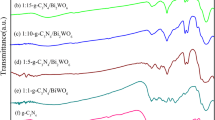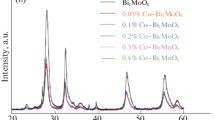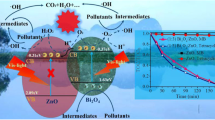Abstract
Visible-light-driven CdS loaded flower-like Bi2WO6 (Bi2WO6/CdS) heterostructured photocatalyst with surface-enrich CdS nanoparticles were prepared successfully by using a facile two-step method. The as-prepared photocatalyst was characterized by X-ray diffraction, scanning electron microscopy, and UV–Vis diffuse reflectance spectrum. The band gaps of the samples were estimated based on diffuse reflectance spectrum results. The as-prepared Bi2WO6/CdS heterostructured photocatalyst was used as catalysts in reduction of Cr(VI) to Cr(III) under visible light irradiation, and enhanced photocatalytic activities were observed as compared to pure flower-like Bi2WO6 and CdS nanoparticles. The origin of the excellent performance of the catalyst as well as the mechanism of photoreduction was discussed. Effective electron–hole separation and variation of band gap due to the formation of type II heterostructure is believed to be responsible to the much improved reaction rate.
Graphical Abstract
Flower-like Bi2WO6/CdS heterostructures was used to photoreduce toxic Cr(VI) to Cr(III) under visible light irradiation. 99% reduction of Cr(VI) could be reached within 10 min. It is found that the heterogenization favors the facilitated interfacial charge transfer and inhibited electron–hole recombination.







Similar content being viewed by others
References
Hu EL, Gao XH, Etogo A, Xie YL, Zhong YJ, Hu Y (2014) Controllable one-pot synthesis of various one-dimensional Bi2S3 nanostructures and their enhanced visible-light-driven photocatalytic reduction of Cr(VI). J Alloys Compd 611:335–340
Li H, Wu T, Cai B, Ma WG, Sun YJ, Gangstar SY, Han DX, Niu L (2015) Efficiently photocatalytic reduction of carcinogenic contaminant Cr (VI) upon robust AgCl:Ag hollow nanocrystals. Appl Catal B 164:344–351
Zhang L, Bahnemann D (2013) Synthesis of nanovoid Bi2WO6 2D ordered arrays as photoanodes for photoelectrochemical water splitting. ChemSusChem 6:283–290
Wu J, Duan F, Zheng Y, Xie Y (2007) Synthesis of Bi2WO6 nanoplate-built hierarchical nest-like structures with visible-light-induced photocatalytic activity. J Phys Chem C 111:12866–12871
Deng WY, Li H, Li L, Qin B, Fan Z, Zhao YB (2014) Photocatalytic reduction of Cr(VI) under visible light over Bi2WO6 with different morphologies. Chem Lett 43:729–731
Zhang ZJ, Wang WZ, Shang M, Yin WZ (2010) Low-temperature combustion synthesis of Bi2WO6 nanoparticles as a visible-light-driven photocatalyst. J Hazard Mater 177:1013–1018
Zhu SB, Xu TG, Fu HB, Zhao JC, Zhu YF (2007) Synergetic effect of Bi2WO6 photocatalyst with C60 and enhanced photoactivity under visible irradiation. Environ Sci Technol 41:6234–6239
Rauf A, Shah SAS, Choi GH, Humayoun UB, Yoon DH, Bae JW, Park J, Kin WJ, Yoo PJ (2015) Facile synthesis of hierarchically structured Bi2S3/Bi2WO6 hotocatalysts for highly efficient reduction of Cr(VI). ACS Sustain Chem Eng 3:2847–2855
Li XN, Huang RK, Hu YH, Chen YJ, Liu WJ, Yuan RS, Li ZH (2012) A templated method to Bi2WO6 hollow microspheres and their conversion to double-shell Bi2O3/Bi2WO6 hollow microspheres with improved photocatalytic performance. Inorg Chem 51:6245–6250
Tang RF, Su HF, Duan SX, Sun YW, Li L, Zhang XX, Zeng SY, Sun DZ (2015) Enhanced visible-light-driven photocatalytic performances using Bi2WO6/ MS (M = Cd, Zn) heterostructures: Facile synthesis and their photocatalytic mechanisms. RSC Adv 5:41949–41960
Chen L, Hua H, Yang Q, Hu CG (2015) Visible-light photocatalytic activity of Ag2O coated Bi2WO6 hierarchical microspheres assembled by nanosheets. Appl Surf Sci 327:62–67
Yu HG, Liu R, Wang XF, Wang P, Yu JG (2012) Enhanced visible-light photocatalytic activity of Bi2WO6 nanoparticles by Ag2O cocatalyst. Appl Catal B 111–113:326–333
Liu CM, Liu JW, Zhang GY, Zhang JB, Wu QS, Xu YY, Sun YQ (2015) Facile room-temperature precipitation strategy for Ag2O/Bi2WO6 heterojunction with high simulated sunlight photocatalytic performance via bi-directed electron migration mechanism. RSC Adv 5:32333–32342
López SM, Hidalgo MC, Navío JA, Colón G (2011) Novel Bi2WO6–TiO2 heterostructures for rhodamine B degradation under sunlike irradiation. J Hazard Mater 185:1425–1434
Jang JS, Joshi UA, Lee JS (2007) Solvothermal synthesis of CdS nanowires for photocatalytic hydrogen and electricity production. J Phys Chem C 111:13280–13287
Ge L, Liu J (2011) Efficient visible light-induced photocatalytic degradation of methyl orange by QDs sensitized CdS-Bi2WO6. Appl Catal B 105:289–297
Ao YH, Xu LY, Wang PF, Wang C, Hou J, Qian J (2015) Preparation of CdS nanoparticles loaded flower-like Bi2O2CO3 heterojunction photocatalyst with enhanced visible light photocatalystic activity. Dalton Trans 44:11321–11330
Zong X, Yan HJ, Wu GP, Ma GJ, Wen FY, Wang L, Li C (2008) Enhancement of photocatalytic H2 evolution on CdS by loading MoS2 as cocatalyst under visible light irradiation. J Am Chem Soc 130:7176–7177
Cui WQ, An WJ, Liu L, Hu JS, Liang YH (2014) Synthesis of CdS/BiOBr composite and its enhanced photocatalystic degradation for phodamine B. Appl Surf Sci 319:298–305
Li X, Chen JT, Li HL, Li JT, Xu YT, Liu YJ, Zhou JR (2011) Photoreduction of CO2 to methanol over Bi2S3/CdS photocatalyst under visible light irradiation. J Nat Gas Chem 20:413–417
Zhang Q, Wang L, Feng JT, Xu H, Yan W (2014) Enhanced photoelectrochemical performance by synthesizing CdS decorated reduced TiO2 nanotube arrays. Phys Chem Chem Phys 16:23431–23439
Wang R, Xu D, Liu JB, Li KW, Wang H (2011) Preparation and photocatalytic properties CdS/La2Ti2O7 nanocomposites under visible light. Chem Eng J 168:455–460
Hao LX, Chen G, Yu YG, Zhou YS, Han ZH, Liu Y (2014) Sonochemistry synthesis of Bi2S3/CdS heterostructure with enhanced performance for photocatalytic hydrogen evolution. Int J Hydrog Energ 39:14479–14486
Sippel P, Denysenko D, Loidl A, Lunkenheimer P, Sastre G, Volkmer D (2014) Dielectric relaxation processes, electronic structure, and band gap engineering of MFU-4-type metal-organic frameworks: towards a rational design of semiconducting microporous materials. Adv Funct Mater 24:3885–3896
Kim MR, Kang AY, Jang DJ (2007) Synthesis and characterization of highly luminescent CdS@ZnS core–shell nanorods. J Phys Chem C 111:18507–18511
Ke DN, Peng TY, Ma L, Cai P, Jiang P (2008) Photocatalytic water splitting for O2 production under visible-light irradiation on BiVO4 nanoparticles in different sacrificial reagent solutions. Appl Catal A 350:111–117
Ren L, Lei J, Wang JB, Qiu M, Yu Y (2009) Template-free synthesis of BiVO4 nanostructures:II. Relationship between various microstructures for monoclinic BiVO4 and their photocatalytic activity for the degradation of rhodamine B under visible light. Nanotechnology 20:17579–17584
McDaniel H, Heil PE, Tsai CL, Kim KK, Shim M (2011) Integration of type II nanorod heterostructures into photovoltaics. ACS Nano 5:7677–7683
Sakkas VA, Arabatzis IM, Konstantinou IK, Dimou AD, Albanis TA, Falaras P (2004) Metolachlor photocatalytic degradation using TiO photocatalysts. Appl Catal B 49:195–205
Acknowledgements
This work was financially supported by the National Natural Science Foundation of China (Grant No. 21571045).
Author information
Authors and Affiliations
Corresponding author
Ethics declarations
Conflict of interest
The authors declare that they have no competing interests.
Rights and permissions
About this article
Cite this article
Liu, Y., Liu, S., Wu, T. et al. Facile preparation of flower-like Bi2WO6/CdS heterostructured photocatalyst with enhanced visible-light-driven photocatalytic activity for Cr(VI) reduction. J Sol-Gel Sci Technol 83, 315–323 (2017). https://doi.org/10.1007/s10971-017-4416-x
Received:
Accepted:
Published:
Issue Date:
DOI: https://doi.org/10.1007/s10971-017-4416-x




